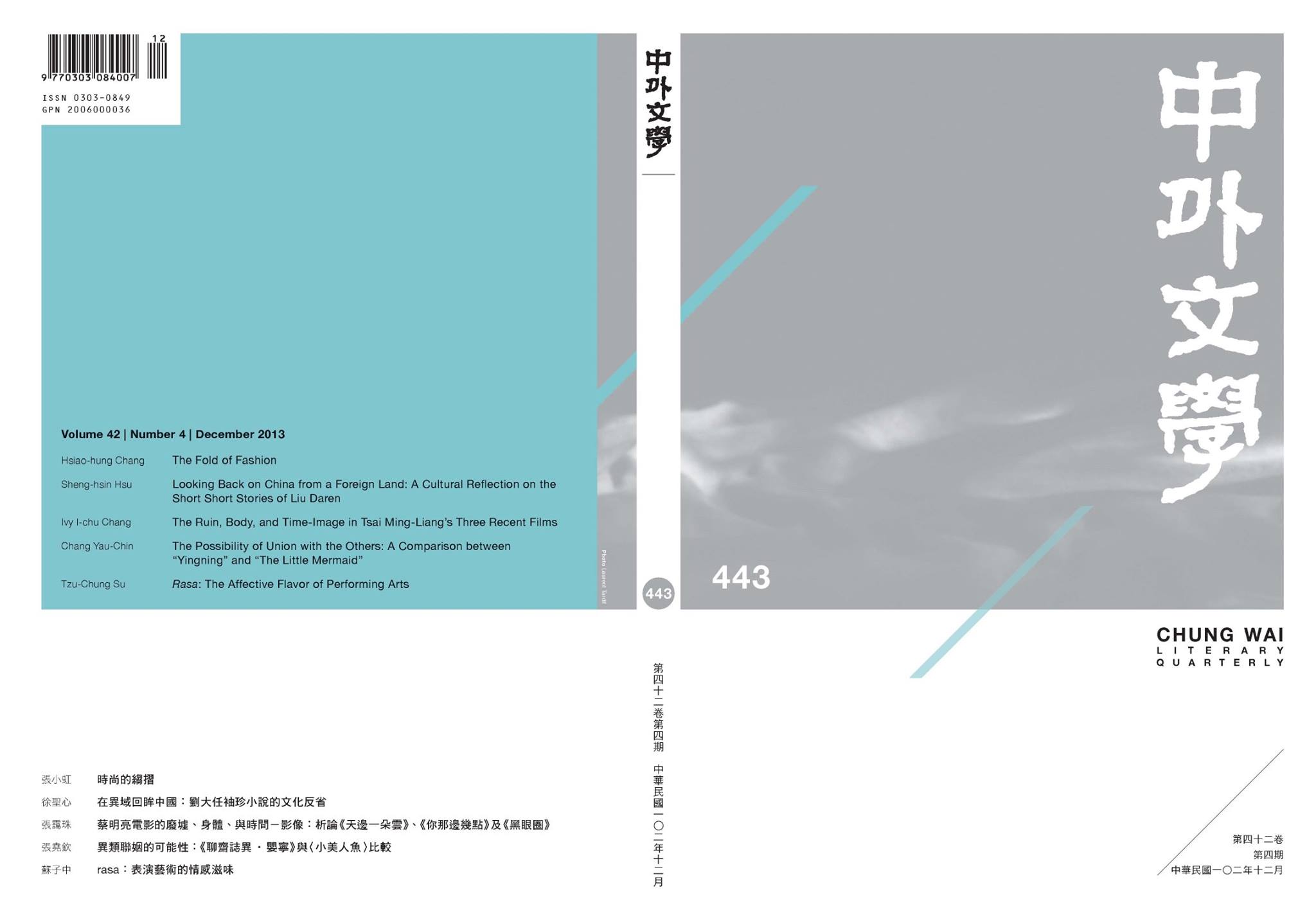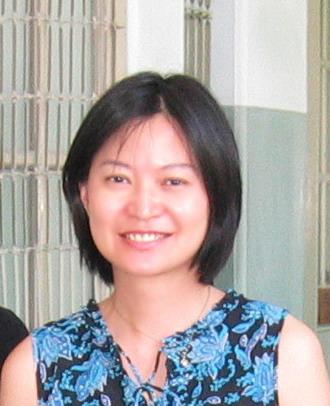第四十二卷 第四期 總443 中華民國102年12月
Vol.42 No.4 December 2013

《中外文學》十二月號收錄了五篇精彩論文。張小虹透過班雅明與德勒茲所建構的「歷史摺學」概念,檢視「旗袍縐摺成洋裝」之歷史案例,探討「歷史摺學」與「時尚」的連結;徐聖心以劉大任袖珍小說為討論範圍,析論科學、宗教、人性等文化交涉時的衝突點;張靄珠分析蔡明亮影片《天邊一朵雲》、《你那邊幾點》與《黑眼圈》,輔以德勒茲相關電影理論,解析身體電影與時間-影像各種形式實驗的可能性;張堯欽探討《聊齋誌異‧嬰寧》與〈小美人魚〉人妖戀故事之共同問題意識,從性別、靈魂、溝通、合偶等面向進行比較,指出其所各自提出的相同或相異的解決方式;蘇子中以古印度梵文rasa的概念為出發點,剖析婆羅多《舞論》裡定義rasa的方式,探索表演藝術的情感滋味。
中外文學十二月號目錄
Contents
張小虹╱時尚的縐摺
時尚的縐摺
張小虹*
摘要
在當代哲學思考中,「縐摺」乃是理論化歷史生成與世界流變的重要關鍵,不論是班雅明談論十九世紀物質文化的《拱廊街計畫》,或是法國哲學家德勒茲談論十七世紀歐洲巴洛克文化的《摺子》,皆以「縐摺」作為探討歷史哲學與主體化的基本概念。而如何通過此兩位理論家建構「歷史摺學」的概念,並以「時尚」作為此概念操作演練的核心,便是本篇論文最主要的企圖所在。本文將以1940 年代殖民地台灣《本島婦人服の改善》計畫中「旗袍縐摺成洋裝」之歷史案例為理論思考出發點,嘗試鋪展「歷史摺學」與「時尚」的連結。全文由三個主要部份構成。第一部份為「歷史摺學」的理論建構,將從班雅明與德勒茲的縐摺理論出發,探討如何在「開摺形式」之差異區分(差分)中,尋覓「合摺行勢」之差異化微分運動(微分),以讓歷史成為「合摺,開摺,重摺」的縐摺運動本身。第二部份則嘗試爬梳20 年代上海平直旗袍與巴黎直筒洋裝,如何在性別現代性作為縐摺之力的褶曲運動中,產生極大化身體速度與極小化性別差異的拓樸連結。第三部份則企圖以本文所開展出的時尚歷史摺學概念,與當前的中西服飾比較史與殖民現代性研究展開對話,進行後設性的反思與批判,並嘗試提出「中西合襞」的縐摺概念,以取代殖民現代性時尚論述中最為常見「中西合璧」的封閉套式,以期積極凸顯當代時尚研究以「拓樸思考」取代「類型思考」在美學、政治與理論上的迫切必要性。
◎關鍵詞:縐摺,時尚研究,旗袍,洋裝,形式,行勢,拓樸學,殖民現代性
★國立臺灣大學外國語文學系教授。
Hsiao-hung Chang╱The Fold of Fashion
The Fold of Fashion
Hsiao-hung Chang*
Abstract
The fold has become one of the key concepts in theorizing the mutability and contingency of history as marvelously demonstrated in Walter Benjamin’s The Arcades Project and Gilles Deleuze’s The Fold. This paper attempts to connect the fold (or pleats) in clothing with the fold in philosophy to map out a creative assemblage that helps to shed new light on both contemporary critical theory and fashion studies. It takes the historical case of dress reform in colonial Taiwan in which the modern Chinese-style cheongsam (qipao) was demanded by the colonial authority to be “folded” into a Western-style dress as a point of departure to theorize history itself as a folding process. The paper is divided into three major parts. Part I tries to negotiate a conceptual connectivity of the fold between Walter Benjamin and Gilles Deleuze to foreground how the “folding forces” of differentiation traverse the “unfolded forms” of differenciation and also how history itself is disclosed as an incessant process of “folding, unfolding, refolding.” Part II argues that the “cheongsamdress (Western one-piece)” in the 1920s was linked topologically as having always already been folded and unfolded in history by the force of modernity as maximizing the moving speed and minimizing the gender difference. Part III attempts to displace the “integration of the Chinese and the Western” model long promulgated in the (post)colonial sartorial analysis with a different conceptualization of the “folding of the Chinese and the Western” in which a topological thinking of fashion can substitute successfully for the typological thinking of the historical costume studies.
◎Keywords: fold, fashion studies, cheongsam (qipao), western dress, form, force, topology, colonial modernity
★Professor, Department of Foreign Languages and Literatures, National Taiwan University.
徐聖心╱在異域回眸中國:劉大任袖珍小說的文化反省
在異域回眸中國
劉大任袖珍小說的文化反省
徐聖心*
摘要
本文以劉大任袖珍小說為主要討論範圍。異域,兼表這些作品中思考的場景、起點與方式,由差異而形成對比,由對比而見出特性,由對比揣摩立場的游移與變化;回眸,則表思想活動時的回顧、反省性,或眷戀之故,或為了認清與再確認;中國,在回眸中,所見的故鄉,也是心情與文化的故鄉,以是為其作品中不斷回歸的主題。論者已夥,本文擇其尚未被深論的篇目和主題,並加有機的組織,分論四個子題,既與當代中國人處境息息相關,同時也是文化交涉時的衝擊點:科學與宗教、「中國/人,遺忘在美國/世界的邊緣」、閃爍在鬥爭中的人性光輝、文化型態之爭衡與和解。小說中有著對科學、宗教的反省與包容;雖描寫政治種種不堪,對政治、鬥爭的幻滅感,也同時呈現人性中不待教而自發性的善意;痛惜近代中國及中國人的屈辱和流浪姿態,描寫其邊緣與雜碎的實況,突顯文化主體的失落、及文化追逐下的集體遺忘;並從文化衝突的兩代、三代拔河,以及在文化優劣等爭衡中,能以交錯融合的方式和解,達至圓熟的境界。
◎關鍵詞:劉大任,《劉大任袖珍小說選》,文化論述,科學,宗教,人性
★國立臺灣大學中國文學系教授。
Sheng-hsin Hsu╱Looking Back on China from a Foreign Land: A Cultural Reflection on the Short Short Stories of Liu Daren
Looking Back on China from a Foreign Land
A Cultural Reflection on the Short Short Stories of Liu Daren
Sheng-hsin Hsu*
Abstract
The essay aims to examine the short short stories of Liu Daren Liu. These stories delineate his experience of looking back on China from a foreign land. The foreign land is the basis of the setting, the starting point, and the modes of reflection in the stories: the differences in locales create contrasts, present distinctive features, and lead to changes in perspective. Looking back involves reflectiveness of thought, nostalgic affection, and the hope to recognize and reaffirm one’s cultural identity. China, as Liu looks back, is not merely a native land, but a spiritual and cultural homeland; therefore, it becomes a recurring theme in his stories.
As Liu’s works have been much discussed, this essay will focus on the themes and sections which have not been deeply explored and classify them into four categories, which are not only closely related to the predicament of contemporary Chinese people but also illuminate the points of conflict in cross-cultural interaction: 1. Science and religion; 2. China/Chinese and the sense of being forgotten in the margins of America and the world; 3. humanity reaffirming itself through struggles; and 4. the competition and reconciliation of cultural differences. It is finally argued that Liu expects to reconcile the cultural conflicts on these four accounts to achieve eventual harmony.
◎Keywords: Liu Daren, Selected Short Short Stories by Liu Daren, cultural discourse, science, religion, humanity
★ Professor, Department of Chinese Literature, National Taiwan University.
張靄珠╱蔡明亮電影的廢墟、身體、與時間-影像:析論《天邊一朵雲》、《你那邊幾點》及《黑眼圈》
蔡明亮電影的廢墟、身體、與時間-影像
析論《天邊一朵雲》、《你那邊幾點》及《黑眼圈》
張靄珠*
摘要
本文藉著對蔡明亮三部影片《天邊一朵雲》(2003)、《你那邊幾點》(2001)以及《黑眼圈》(2006)的文本分析和德勒茲的身體電影和時間-影像理論對話,針對影像、身體和時間之間的辯證與弔詭進行哲學和美學的思考,同時從電影操作實踐層面來探索身體電影和時間-影像種種形式實驗的可能性。蔡明亮不僅在三部電影中呈現了角色/職業非演員那疲憊等待的日常身體之影像時延(以及「之前」「之後」),亦把日常身體和儀式身體相互迴入的晶體影像,嵌入觀視與慾望的迴圈以及電影類型的揉雜互文,並往復於非歷時性時間的時叉、積層、和延展,以探索身體、時間、影像之種種可能關係。《天邊》的「媒介-身體」色情展演不僅是酷兒情慾操演,亦是把身體極度視聽情境化。「一場愛、三人做」以誇張怪誕的情境和影像構圖,透過一連串觀視、慾望、以及身體的置換,來諧仿親密關係之不可能以及身體的幻視/幻識情境性。《你那邊》則是藉著和楚浮電影的互文、去畛域的時間、以及身體和時間-影像之相互轉喻,往復於時間的積層和延展之間、來連結台北-巴黎的日常身體展演和蔡明亮-楚浮的影像記憶。《黑眼圈》則是把吉隆坡的歌劇院去畛域變成任意空間,呈現「一張床、三人睡」那兼具時延與介面,既為整體又能獨立存在的酷兒動情-影像,又經由小康和植物人的鏡淵關係與「我就是另一個人」的偽造敘事,來牽引那已然存在或發生於未然的世界-記憶與動情力。
◎關鍵詞:蔡明亮,台灣電影,德勒茲,身體,時間-影像,廢墟
★國立交通大學外國語文學系教授。
Ivy I-chu Chang╱The Ruin, Body, and Time-Image in Tsai Ming-Liang’s Three Recent Films
The Ruin, Body, and Time-Image in Tsai Ming-Liang’s Three Recent Films
Ivy I-chu Chang*
Abstract
Focusing on Tsai Ming-liang’s films, Wayward Cloud (2003), What Time Is It There (2001), and I Don’t Want to Sleep Alone (2006), this essay enacts a dialogue between those films and Gilles Deleuze’s theories and methodology of “the cinema of the body” and “time-image” to undertake a metaphysical and aesthetic contemplation of the dialectical and paradoxical relationship between cinema, body, and time. In the three films, Tsai’s cinematic experiments include presenting the durée (and “before and after”) of the characters/nonprofessional actors’ everyday bodies through camera, superimposing the crystalline circuit between the everyday body and the ceremonial body and between the actual image and the virtual image with the voyeuristic gazedesire circuit, practicing cinematic intertextuality and hybridization of various film genres, and exploring non-chronological time and “Cronos,” opening up the infinite possibilities in exploring the relationship between the body, time, and cinema. In Wayward Cloud, the hyperbolic pornography of “media-body” not only enacts queer performativity, but also turns the body into the pure opsigns and sonsigns via a series of displacement and substitution of desire, gaze, and bodies, revealing the illusionary and phantasmatic situation of body. In What Time Is It There, with strategic deterritorialization of time and place and the metonymy between body-image and time-image, Tsai presents the Taipei-Paris everyday bodies and Tsai Ming-Liang-François Truffaut cinematic memory via the intertextuality between his and Truffaut’s films. In I Don’t Want to Sleep Alone, Tsai deterritorializes the ruin of an opera house in Kuala Lumpur, turning it to any-space-whatever to make palpable the complex entity of affection-images which serve as durée, interface, and trans-image in crystallizing the false narrative of “I is another” connected to the déjà-la worldmemory and affect.
◎Keywords: Taiwan Cinema, Tsai Ming-Liang, body, ruin, time-image, Deleuze
★Professor, Department of Foreign Languages and Literatures, National Chiao Tung University.
張堯欽╱異類聯姻的可能性:《聊齋誌異‧ 嬰寧》與〈小美人魚〉比較
異類聯姻的可能性
《聊齋誌異‧ 嬰寧》與〈小美人魚〉比較
張堯欽*
摘要
〈嬰寧〉與〈小美人魚〉的內容都改編自人妖戀傳說,就深層意義而言,更蘊含共同的問題意識。本文從性別、靈魂、溝通、合偶等四個面向進行比較,指出它們各自所提出的相同或相異的解決方式。一、人妖戀主角大都為男人與女妖,固然是男性中心社會的性愛想像,兩篇作品卻也獨具對女性處境與成長歷程的觀照。二、異類與人類結合為了追求靈魂的救贖,渴望將自身的動物性存在予以提升,是中西異類相同的目標。三、兩主角皆非以語言作為主要溝通工具,而是一以笑,一以舞,但外在環境條件的不同與所費心機的深淺構成其成敗之別。四、求偶故事可視為內心發展的象徵,但其中的三角關係蘊含特殊的對應結構,反映出人類對自然的恐懼,結局的不同則肇因於兩作品背後意識形態對異類接受程度的差異。
◎關鍵詞:人妖戀,兩性關係,靈魂救贖,溝通,整合
★慈濟大學英美語文學系助理教授。
Chang Yau-Chin╱The Possibility of Union with the Others: A Comparison between “Yingning” and “The Little Mermaid”
The Possibility of Union with the Others
A Comparison between “Yingning” and “The Little Mermaid”
Chang Yau-Chin*
Abstract
The contents of “Yingning” and “The Little Mermaid” are both adapted from the traditional love story between the human and the non-human. They both also contain a sensibility of problems in their deep structure. This article compares the two works from four perspectives—gender, soul, communication and marriage—and points out the similar or different ways they offer to solve the problems. (1) The erotic imagination of patriarchal society is expressed in the love between human males and non-human females, which also reflects insights into the human female situation and what constitutes a growth to maturity. (2) As the non-humans associate with the humans in order to get salvation for their souls, the common goal of the Chinese and European nonhumans is to sublimate their original animalness. (3) The main communicative means for the protagonists of these two works is not language, but laughter and dance respectively; their success or failure results from the differences in their external conditions and the efforts they spend oncommunication. (4) In the courtship plot, which is a symbol for inner development, there is a triangular relationship which implies human fear of nature. All in all, the different endings of the two works are to be explained in terms of their different attitudes toward the Others.
◎Keywords: non-human love, gender, salvation of soul, communication, integration
★Assistant Professor, Department of English Language and Literature, Tzu Chi University.
蘇子中╱rasa:表演藝術的情感滋味
rasa
表演藝術的情感滋味
蘇子中*
摘要
rasa(梵文)是味、是味道、是汁液、是滋味、是美感、是情緒、是香料、是愛、是慾望、是本質、是精髓,是色香味的完美融合,是情緒的淬煉與呈現、是情感的感知與境界的提升;在此同時,rasa 也是品味與賞味,是讀者或觀眾的鑑賞能力與本能反應,也是表演者與賞味者(或參與者)共同成就的境界。rasa 是一個無法確切捕捉、翻譯的字,但它不僅是印度梵語詩學與美學之重要概念之一,更是古老梵語表演藝術經典論著《舞論》的理論核心。本論文把重點聚焦在表演藝術情感滋味的討論上。在進行的步驟上,論文首先檢視婆羅多在《舞論》裡建構、定義rasa 的方式,並從歷史的角度探尋rasa 在情感層面的意涵轉化昇華及超凡入聖的過程與秘方。本論文也會就表演者的表演實踐與觀眾的情感反應這兩個面向作深入的探討。最後本論文會進一步探究rasa 所蘊育出來的表演藝術境界,並針對rasa 的審美詮釋取向提出反思與批判。
◎關鍵詞:rasa,表演藝術,情感,婆羅多‧ 牟尼,《舞論》
★國立臺灣師範大學英語學系教授。
Tsu-Chung Su╱Rasa: The Affective Flavor of Performing Arts
Rasa
The Affective Flavor of Performing Arts
Tsu-Chung Su*
Abstract
Rasa (Sanskrit) is taste, f lavor, juice, relish, aesthetic sensibility, emotion, spice, love, desire, and essence. It is at once the perfectly blended masala and the presentation of affective sensibility. Meanwhile, rasa is always a matter of tasting which has to do with spectator’s response. It is also the joint achievement of performers and partakers. Rasa is a word that cannot be captured and translated in a precise manner. Nevertheless, it is not only one of the vital concepts of Indian aesthetics but also the core theory of the Nātyaśāstra. This paper focuses on discussing the affective flavor of performing arts. First of all, it examines the way Bharata Muni defines the notion of rasa in the Nātyaśāstra. It next explores the process or secret formula that heightens and sublimates the affectivity of rasa into a higher and sacred realm. This paper then proceeds to look into the rasic performance from not only the perspective of the performer but also the affective viewpoint of the audience. Finally, it brings forth the whole gamut of the rasicperformance and proffers a critique of the interpretative act and tendency of aestheticization bearing on the notion of rasa.
◎Keywords: rasa, performing arts, affect, Bharata Muni, the Nātyaśāstra
★Professor, Department of English, National Taiwan Normal University.


